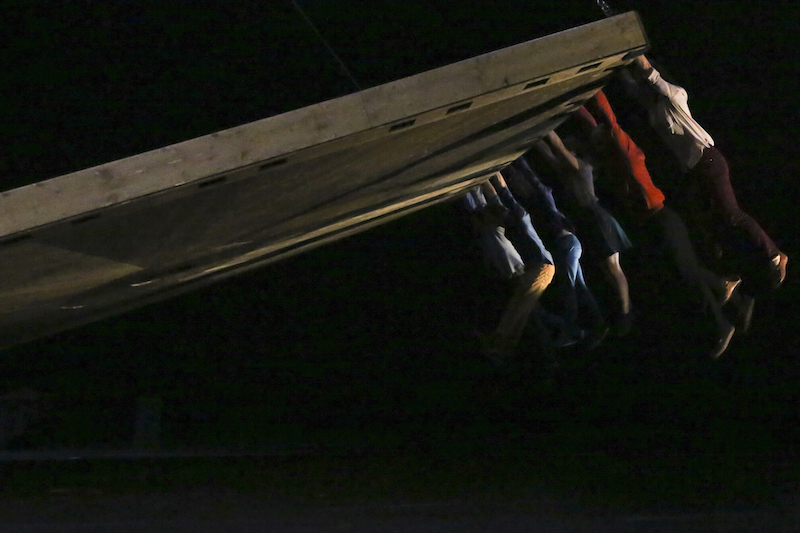Barbican Theatre, London International Mime Festival; 6th February 2016

As the curtain rises for He Who Falls (Celui Qui Tombe when not anglicised for this festival), a wooden platform lowers. A platform that, we see, has a haphazard scattering of bodies lying across it, starting to slide towards the edge as it begins to tilt.
This is a platform that will continue to tilt, spin, invert, raise and lower for the next 65 minutes, while the people on board embark on a series of negotiations with their weight and gravity that – despite this simplicity of description – are part of an existential marvel, which remains accessible and light whilst creating space to contemplate the complexities of human relations, power imbalances, and endeavour.

The performers in Yoann Bourgeois‘ company are Jean-Baptiste André, Mathieu Bleton, Elise Legros, Francesca Ziviani, co-director Marie Fonte, and Julien Cramillet (who, although this is not a play with a protagonist, is a figure who we are brought to focus on several times for a comic touch). Their biographies proclaim them to be from a mixture of dance, acrobatic and circus backgrounds, and there are times when this physical training is apparent – such as when they hang from their wooden world by the hands for an excruciating length of time until they drop, or when they teeter on the edge of a platform that revolves away beneath their feet. At others, though, it takes a conscious effort to remember that what looks so easy and natural is carefully planned and achieved only by concerted training. A race run in a seemingly straight line before us takes a precisely calculated path to maintain the illusion of a steady surface when the ground is actually revolving beneath the runners’ feet. A group travel from one corner of the spinning wooden playing board, knowing exactly at what angle they can lean before falling as the centrifugal force plays upon their bodies, straightening as they reach the centre, then being pulled into a sharper angle again, but backwards, as their walk continues on to the other corner.

The colours and styles of clothing are mixed to suggest any group of strangers grabbed from the street or supermarket, and there is nothing in the performers’ interactions to suggest characters who know each other. What we see is individuals, but individuals who are on the unpredictable treadmill of life together. There is another man, who sits at a control desk on the Barbican’s stage-proper, who walks with a limp, and who seems in charge of adjusting the movement capacity of the shifting stage. He attaches and unattaches suspending cables, and one assumes that he is also responsible for the shifts in tilt and turn while the platform rests upon its central pivot on the theatre’s usual mainstage. There is a suggestion too, that some of the movement stems from the adjusting balance of the performers atop the precarious square, although the illusion of fakery – ‘des jeux de simulacres‘ – is one of the ruling games that inspires Bourgeois’ work, and who’s to know?
The other central game, which combines with the first to form the concept of circus from which the company work, is that of vertigo (‘des jeux de vertiges’), and the feeling skips from their bodies to mine as I watch the heavy physical forces at play on the tiny, fragile human frames.

There is another man, who steps onstage at one point to watch the proceedings from a darkened downstage corner, with his arms crossed. Later a team of workmen with headtorches and spanners appear to dismantle and remove the rotation device after the platform has been raised again into suspension following its sojourn connected to the ground. Whatever universe we know, there’s another universe going on behind the scenes.
Lighting isolates – then reintegrates – the microcosmic world with that of the full Barbican stage, and music floats in and out… classical strains of strings and opera; Frank Sinatra (both forwards and in reverse, and from far away over the controller’s hidden work radio); choral acapella harmonies sung by the acrobats as they lift each other from the underside of the hanging stage to the relative and temporary safety of its top surface. Even more impactful are the sounds of the wooden floorboards creaking as the performers move across it, or the whirring of the machinery as it turns. There’s no escaping that this is really happening and that there is the real possibility of mishap as the actors keep a careful watch over each other’s footsteps when stumbling too close to the edge of their treacherous island.

The thing about watching this show is that it all makes sense, however bizarre it may sound. This is circus as it expresses the unavoidable aspects of humanity, bodies behaving as bodies must in the face of what the world throws at them. ‘L’art vivant a une responsabilité éthique d’ordre existentialiste’ says the blurb on the company website: ‘Living art has an ethical responsibility to existentialist order.’ Interpretation is almost below the level of conscious thought and deeply personal – and He Who Falls is deeply satisfying for that.
.




